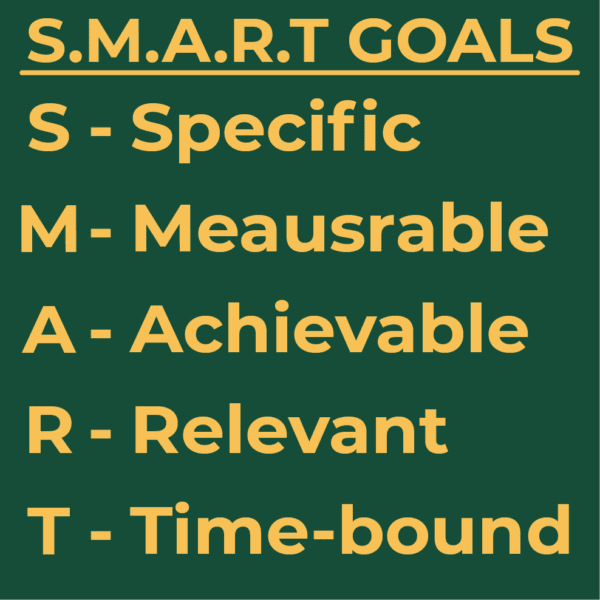SMART goals are the most popular and effective way of setting goals. The 5 elements that S.M.A.R.T. consists of allow you to achieve whatever you want to achieve.
In this post, we’ll break down each element of the SMART goal setting system. You’ll learn how to set and achieve a SMART goal.
If you’d like to learn more, in detail, about goal-setting and the different types of goal, check out our Ultimate Guide To Goal-Setting.
What are SMART goals?
SMART goals have 5 core parts, one for each letter. SMART is an acronym that stands for:
- Specific
- Measurable
- Achievable
- Relevant
- Time-bound
Each of these 5 parts in a SMART goal plays an important role. They work together to make goal-setting and goal-achieving easy and effective.
S – Specific
The S in SMART goals stands for Specific.
When setting goals, make sure they are well-defined. To achieve exactly what you want, you must have a specific definition of the outcome you want. Without a well-defined goal, you’ll have little motivation to make progress.
An unclear goal will be difficult to achieve. Your action steps will lack structure and you’ll struggle to know what to do. For an increased chance of completing your goal, make sure it’s Specific.
M – Measurable
An effective goal needs a way of tracking your progress. Without this, you’ll be unable to see what’s working and what needs changing.
A Measurable goal allows you to set targets and milestones. Doing so will keep you on track and keep you motivated.
For more effective results, define how much progress you must make to achieve your goal. Split this into regular intervals which will act as milestones.
A – Achievable
Unless your goal is achievable, you’ll feel unmotivated to make progress. When setting your goal, consider your current skills and how much you can develop in a given period of time. Is it possible, with your current skills, to achieve the goal before the given deadline?
Think about how much outside forces can impact the completion of your goal. An Achievable goal is a goal that you complete without much influence or input from others. The more a goal can sway due to outside sources, the less likely you are to achieve it.
R – Relevant
An effective goal is relevant to your current life or your long-term plan. An irrelevant goal won’t provide any motivation. When your goal is relevant, you’ll feel inspired to make a change and make progress.
T – Time-bound
This is the most important of the 5 parts of SMART goals.
Without a deadline, your goal can go on forever. You won’t be making significant enough progress each day to achieve said goal. This is due to Parkinson’s Law:
Work expands to fill the time available for its completion
A sense of urgency prompted by a deadline will increase your productivity. You’ll achieve more and make more progress when a goal is Time-bound.

A Simple Step-By-Step Process To Set SMART Goals
Now that you know the 5 parts of SMART goals, we can begin the goal-setting process.
Step 1 – Begin by deciding what goal you want to achieve
Be specific and ensure the goal is relevant to your present or future life. Think about the exact outcome you want to reach, then provide as much detail as possible.
For example, ‘I want to run 5 miles within 45 minutes without stopping.’
Step 2 – Decide on your form(s) of measurability
The more factors you can measure, the better.
In our example, these would be:
- Distance ran
- Time of completion
- Number of rests
Step 3 – Think about outside forces
How much can outside forces influence the completion of your goal?
Consider these outside forces as obstacles. For each obstacle, create an action plan to overcome said obstacle when it occurs. This will increase the likelihood of you achieving your goal.
In our example, one obstacle could be the weather.
If it’s raining on a training day, you could overcome this obstacle by wearing a raincoat.
If it’s hot and sunny, you could wear light clothing and bring a bigger water bottle.
Step 4 – Set a deadline
Make use of a deadline to activate Parkison’s Law.
If your deadline is too close for a difficult goal, you’ll feel unmotivated. You’ll have to make a lot of progress in a short amount of time, which is difficult.
If your deadline is too far away, or non-existent, your daily progress will be minimal if at all.
Instead, set a date that you think is achievable and appropriate to the work required. For an extra challenge, bring this forward by a little. Doing so will push you to work harder and allow you to make more daily progress.
Step 5 – Get to work!
That was super easy, right? Now for the actual work. Start working towards your goal as soon as possible. The sooner you start, the better, since you’ll be able to build momentum which will provide motivation.
Thanks for reading.
If you enjoyed this post or found it useful, share the site with your friends. We have loads of other useful posts if you want to learn more, so have a browse. Cheers!
Comments
4 responses to “How To Set SMART Goals”
[…] most popular and effective system for setting goals is S.M.A.R.T goals. Let’s begin with looking at this type of goal, followed by some other types that you can […]
[…] How To Set SMART Goals […]
[…] Read through the previous section on deadlines for more information. You can learn more by looking into SMART goals. […]
[…] most popular and effective system for setting goals is S.M.A.R.T goals. Let’s begin with looking at this type of goal, followed by some other types that you can […]